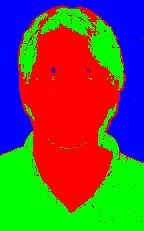CSE/EE 576 Spring 2010: Project 1
Color Clustering and Skin Finding
Date released: Wednesday, March 31, 2010
Date due: Friday, April 16, 2010 11.59pm
(Late
policy: 5% off per day late till Sunday,
April 18, 2010)
Download the C++ skeleton code for project 1.
Matlab users create your own code, do not use Matlab K-Means function.
Download the images you need:
1. Faces training set
2. Faces testing set
3. Faces
training groundtruth set
4. Faces
testing groundtruth
5. Scenes
Download .doc template for the
report (proj1-report.doc). You are free
to use other text processing tools like latex etc, however make sure
that you have the same sections in your report.
Download project grading
guidelines for the project here.
In this assignment, you will segment images by color, using the
K-means algorithm and some variants.
You will also try to classify the skin areas on the face images
using the generated clusters.
 |
 |
 |
| face image |
segmented by color |
skin pixels highlighted |
What You Should Do
Part I: Color Clustering
- First implement a basic K-Means Clustering Algorithm (your own
code; do not
use the MatLab K-Means). Try several color spaces: RGB, normalized RGB,
HSV or any other color space.
- First with randomly selected cluster seeds
- Next try sampling pixels from the image to find the seeds.
Choose a pixel
and make its value a seed if it is sufficiently different from
already-selected
seeds. Repeat till you get K different seeds.
- Next with a method that you develop for selecting the seeds
intelligently from the image using its color histogram (again your
code). The seed selection should be automatic, given the histogram
and the number of seeds to be selected. One way to go is to find the
peaks in the color histogram as candidates for seeds.
- Now develop and implement a smarter K-Means variant (your own
code again)
that determines the best value for K by evaluating statistics of the
clusters.
Some possible methods to try:
- You can start from the color histogram, as K is closely
related to the number of peaks in the histogram. Not all the peaks are
necessary as you want only the dominant ones, so you should pick the
ones that occupies a certain portion of the image in terms of pixels.
- You can also try clustering using different Ks, and pick the
best one. The metric could be related to the distance between clusters
and the variance within each cluster.
- You are free to come up with your own ways.
- Test each variant of the above on both the following face images
and scene images and report your results: face01, face04, face05,
face08,
face10, face23, face28, s03, s06, s08, s09, s12.
Your k-means code should output an image that can be used
to show your clusters. This can be a grayscale image where each
pixel's value is the number of the cluster to which it has been
assigned, which the provided autocolor
function will transform into something more easily interpretable. It
could also be a ppm where each pixel has the mean color of the cluster
it was assigned to (this generally makes a prettier picture, but it can
be harder to tell the number of clusters), or better yet output both.
Part II: Skin Classification
The goal of this part is to develop a very simple
skin detector from the results of Part I. For this part of the
homework, we recommend that you work in normalized RGB space.
The common RGB representation of color images is not suitable for
characterizing skin-color. In the RGB space, the triple component (r,
g, b) represents not only color, but also luminance.
Luminance may vary across a person's face due to the ambient lighting
and is not a reliable measure in separating skin from non-skin regions.
Luminance can be removed from the color representation in the
normalized RGB space or chromatic color space. Chromatic
colors,
also known as "pure" colors in the absence of luminance, are defined by
the simple normalization process shown below:
r = R/(R+G+B)
g = G/(R+G+B)
Note: r+g+b = 1.
- Start with the face training image set (face-training.zip).
- Run your K-means algorithm on the face training set
to get K clusters with small K, ie K < 9.
- Keep the information of the cluster index for each pixel and the
cluster centroid (average r and g value).
- Use the groundtruth images (face-training-grountruth.zip) to
assign the final cluster label (skin or non skin) for training. You can
use majority vote of the pixels in each cluster as the cluster label.
- Use a classifier to learn the skin model. You can use WEKA and test
out your model using a Naive Bayes classifier and a number of other
classifier. A short WEKA tutorial is provided here
You will need to generate your
training and testing data file in the proper ARFF format. The training
and testing data file will contain the cluster centroid and the
cluster label (Sample of training and
testing ARFF file). You want to
obtain a skin model with high classification
accuracy.
- Test your skin model on the face test image set
- Report on its performance: classification accuracy and include
some images as well.
What You Should Turn In
1. All of your code that is created for the above Part I and II. Your
code must be well commented and in the ASCII format so that the grader
can compile it to working binaries.
You should put headers on all your routines with the
following information:
- Your NAME
- DATE
- TITLE of the routine
- DESCRIPTION of the routine
- PARAMETERS of the routine
2. Write a brief report on the performance of:
- your smart K-means
algorithm
- your skin classification. Provide your classification accuracy
and some image results.
Your
report must clearly describe and explain the
algorithms you developed.Also
include
some discussions on failure examples or limitations for your approach;
this will shed light on future improvements.
This report can be a Word
document or pdf document. HTML or webpages are not accepted. Your
report must include output images of your
algorithm.
Please email your code and report to Indri (indria@cs) in a zip file
with your name as the zip file name e.g. JohnDoe.zip, by Friday, April 16, 2010 11.59pm.





